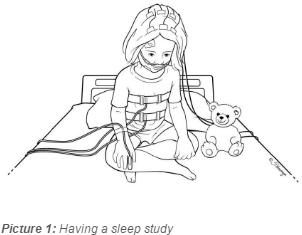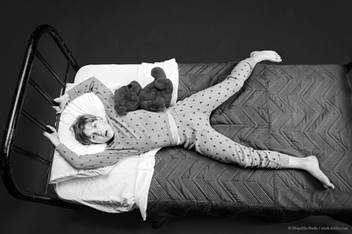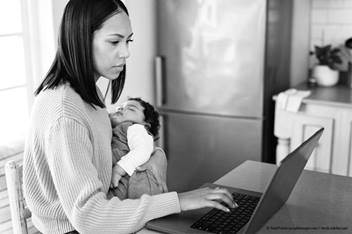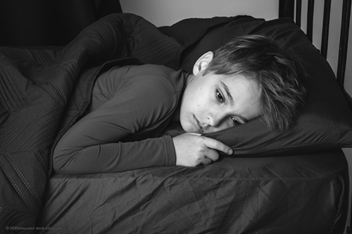Sleep Study
![]()
A sleep study, or polysomnogram (pol ee SOM no gram), is a test that measures and records several things that happen during a child’s sleep. What is measured depends on the kind of sleep problems your child is having.
Some of the tests use small metal discs, called electrodes. The electrodes do not hurt your child (see Picture 1).

-
For an EEG these electrode discs are put on the scalp to measure brain activity.
-
For an EKG the disks are put on the chest to measure the heartbeats.
Other things that may be measured include:
-
Eye movements - electrodes are put above and below the eyes
-
Muscle movements – electrodes are put on the chin
-
Limb movements – electrodes are put on the legs or arms
-
Breathing – sensors are placed near the mouth and nose to measure the flow of air. Small elastic belts are put around the chest and waist to track when the child breathes in and out.
-
O2 (oxygen) saturation – a sensor is put on a finger or toe to check oxygen levels
-
ETCO2 monitor – a sensor is placed near the nose to measure the amount of carbon dioxide when the child breathes out.
Why the Tests Are Done
Sleep studies are often ordered to find out if a child has problems breathing while asleep. Obstructive sleep apnea (OSA) is one of the most common reasons for doing a sleep study. It is often found in children who snore, gasp for air, or stop breathing while asleep.
Children with enlarged tonsils may also have apnea (AP-nee-uh). However, there are many other reasons why your doctor may want your child to have these tests. A doctor who is specially trained in sleep medicine will review the results of the sleep study. The report will be sent to your child’s doctor’s office or clinic.
How the Tests Are Done
-
A sleep technician will talk to you and your child about how the test is done.
-
All children under the age of 1 year will be required to sleep in a crib.
-
Your child will not be sedated (given medicine to make him or her sleepy) during the sleep study, so we may need to wrap him in blankets or place him on a papoose board while the disks are being put on the scalp. A blanket or papoose board may also be used to keep a child from rolling around on the bed or pulling on the wires.
-
Several small areas of your child's scalp, face, chest and legs will be prepared for the test by gently rubbing with a Q-tip and mild cleanser. Small round discs, called electrodes, are then attached to the scalp using gauze squares and glue (Picture 1).
-
The glue is gently blown dry with a hand-held dryer. The dryer sounds like a hair dryer at home. The electrodes are filled with a paste that makes contact with the scalp. This allows brain activity to be measured.
-
Your child’s skin may get a little pink. Wires from the discs are then attached to a small box. Faint electrical impulses of the brain and the signals from the other sensors and belts are sent to a computer in the control room.
-
A finger stick blood test is done on every patient in the morning before you go home.
-
After the study, the glue that held the discs in place is easily removed with shampoo.
Sleeping with the Electrodes On
Most children sleep pretty well in the sleep center if all the test guidelines are followed. The body sensors are put on so that your child can turn and move around during the night. Your child will probably not know the sensors are on after wearing them for a short time. The staff tries to make each child as comfortable as possible.
Going to the bathroom is very easy. All the wires that are attached to your child are plugged into a box. If your child needs to use the bathroom, tell the technician. The technician will come in and unplug your child from the box and he will be free to walk to the bathroom.
Other Tests
If the doctor needs more information than what the sleep study shows, other special tests might be ordered. These may include:
-
CPAP – Some children need to have a test done with a machine that helps them breathe at night. This is a lot like a regular sleep study, but the child wears a mask over the nose while he or she sleeps. The mask is connected to a breathing machine. If the doctor feels that you need equipment to use at home, one of our respiratory therapists will call you and explain how to get what you need.
-
MSLT (the Nap Test) – Some children stay for more testing during the day after an overnight sleep study. This test is called the Multiple Sleep Latency Test (MSLT) or the Nap Test. Your child will take four or five 20-minute naps, spaced two hours apart during the daytime. This measures a lot of the same things as the overnight study. Usually, the MSLT is over by 6:00 p.m. and your child may be ready to go home.
HH-III-103 12/04, Revised 4/15 Copyright 2004, Nationwide Children’s Hospital



